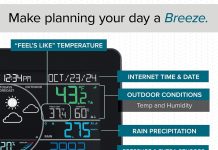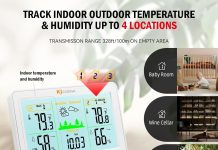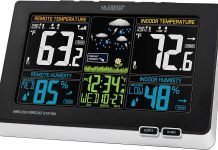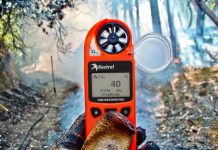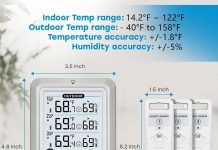Have you ever wondered how accurate wind speed measurements are on home weather stations? In our article, we explore the accuracy of these measurements and discuss the factors that can affect their reliability. Join us as we uncover the truth behind home weather station wind speed measurement and discover if these devices are truly trustworthy in providing accurate weather information.
Review contents
Factors Affecting Accuracy of Home Weather Station Wind Speed Measurement
When it comes to measuring wind speed using a home weather station, there are several factors that can impact the accuracy of the measurements. As weather enthusiasts, it is important for us to understand these factors in order to ensure the reliability of the data we collect. Let’s take a closer look at each of these factors and how they can affect the accuracy of wind speed measurement.
Quality of Anemometer
The anemometer is the instrument responsible for measuring wind speed. The quality of the anemometer plays a crucial role in the accuracy of the measurements. There are different types of anemometers available, including cup anemometers, vane anemometers, and sonic anemometers. Each type has its own advantages and disadvantages, and it is important to choose a high-quality anemometer that suits your needs.
Sensor calibration is another important aspect of ensuring accurate wind speed measurements. Over time, sensors can drift and become less accurate. Regular calibration of the anemometer is necessary to maintain its accuracy. It is recommended to calibrate the anemometer at least once a year or as recommended by the manufacturer.
Placement of Anemometer
The placement of the anemometer is crucial to obtain accurate wind speed measurements. Ideally, the anemometer should be placed in an open area away from obstructions that can interfere with the wind flow. Placing it on top of a rooftop or a tall pole would ensure that it is exposed to the true wind conditions.
Obstructions such as buildings, trees, or nearby structures can create turbulence and disrupt the wind flow, leading to inaccurate measurements. It is important to carefully consider the surrounding environment and find a location that minimizes interference from such objects.
The height of the anemometer above the ground also affects the accuracy of the measurements. The higher the anemometer is placed, the less likely it is to be affected by ground-level turbulence. For the best results, it is recommended to install the anemometer at a height of at least 33 feet (10 meters) above the ground.
Accuracy of Wind Direction Sensor
In addition to measuring wind speed, many weather stations also come with a wind direction sensor. This sensor indicates the direction from which the wind is coming. Just like the anemometer, the wind direction sensor needs to be accurate for reliable measurements.
There are different types of wind direction sensors, including mechanical and electronic sensors. Mechanical sensors use a wind vane to determine the wind direction, while electronic sensors utilize various technologies such as magnetic or optical sensors. Calibration of the wind direction sensor is essential to ensure its accuracy. Regular checks and calibration should be performed to maintain the reliability of wind direction measurements.
Interference from Surrounding Objects
The presence of nearby objects such as buildings and trees can significantly impact wind flow, leading to inaccurate wind speed measurements. Buildings create obstacles that can cause turbulent wind patterns and eddies, while trees can create wind shadows and alter the wind speed. It is important to consider the distance and placement of these objects relative to the anemometer to minimize their interference.
Additionally, nearby structures, such as fences or walls, can also affect the wind flow and lead to inaccurate measurements. Make sure to choose a location that is free from such structures to obtain reliable wind speed readings.
Influence of Wind Flow Patterns
Wind flow patterns can vary based on the surrounding terrain. If your home weather station is located in an area with complex terrain, such as mountains or hills, it may experience different wind flow patterns compared to a flat terrain. These variations in wind flow can impact the accuracy of the wind speed measurements.
Boundary layer effects, which occur close to the ground, can also influence the wind speed measurements. The boundary layer is the layer of air near the ground that is directly influenced by the surface. It can be affected by factors such as vegetation, soil moisture, and temperature gradients. Understanding these effects and their impact on wind flow patterns is essential for obtaining accurate wind speed measurements.
Impact of Environmental Conditions
Environmental conditions such as temperature, air density, moisture, rainfall, and barometric pressure can influence the accuracy of wind speed measurements. Changes in temperature can affect the air density, which in turn affects the wind speed. Moisture and rainfall can also impact air density, as well as the wind patterns. Barometric pressure variations can cause changes in wind speed and direction.
To minimize the impact of these environmental factors on wind speed measurements, it is important to choose a weather station that compensates for these conditions or apply appropriate corrections to the data.
Effect of Elevation and Topography
The elevation and topography of the area where the home weather station is located can also affect wind speed measurements. At higher altitudes, the air density decreases, which can result in higher wind speeds. Additionally, slopes and hills can cause changes in wind patterns and speed due to the impact of terrain features.
Understanding the effects of elevation and topography on wind speed is crucial for accurate measurements. Consider the specific characteristics of the location when analyzing the wind data collected from your home weather station.
Wireless Interference and Data Transmission
Most home weather stations come with wireless capabilities for data transmission. However, wireless interference can sometimes affect the reliability of the data received. Factors such as distance, obstacles, and electronic devices can interfere with the wireless signal, resulting in data loss or corrupted measurements.
To ensure reliable data transmission, it is important to choose a home weather station that has a reliable wireless communication system and locate the receiver in an area with minimal interference. Additionally, regular checks of the wireless connection and troubleshooting any issues will help maintain the accuracy of the wind speed measurements.
Calibration and Maintenance of the Weather Station
Regular calibration and maintenance are essential for ensuring the accuracy of wind speed measurements from a home weather station. As mentioned earlier, anemometers and wind direction sensors should be calibrated at regular intervals to correct any deviations and maintain their accuracy.
Maintenance includes keeping the anemometer and wind direction sensor clean and free from debris that can affect their performance. Regular inspection of the weather station’s components, wires, and connections is also important to identify any potential issues that could impact the accuracy of the measurements.
Comparison with Official Weather Stations
One way to validate the accuracy of wind speed measurements from a home weather station is to compare them with data from official weather stations in the vicinity. Official weather stations are equipped with highly accurate instruments and are subject to strict quality control measures. By comparing the measurements from your home weather station with those from an official station, you can assess the accuracy of your own station and make any necessary adjustments or corrections.
It is important to note that even with the best calibration and placement, there may still be slight differences between the measurements from a home weather station and those from an official station. Differences can be attributed to local microclimates, variations in terrain, or other factors. However, maintaining a consistent and reliable comparison with official weather stations will help monitor the accuracy of your home weather station’s wind speed measurements.
In conclusion, accurate wind speed measurement from a home weather station requires careful consideration of various factors. From the quality of the anemometer to the placement of the station and the impact of surrounding objects, each factor plays a role in the accuracy of the measurements. By understanding and addressing these factors, we can achieve reliable and trustworthy wind speed data for our weather observations and forecasts.


